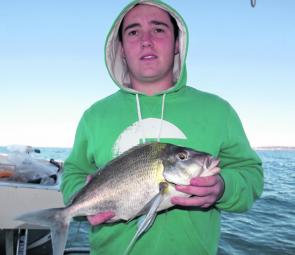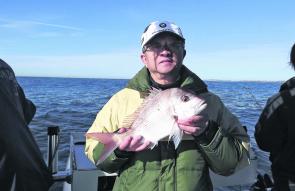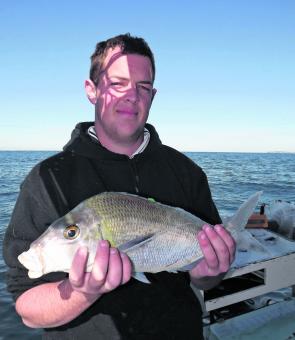Over the next month we should finally see some warmer water bumping along our coast and into Broken Bay and Pittwater.
Lately there have been schools of salmon bursting into action around Broken Bay but you have to be quick. The fish are becoming fixated on the tiny ‘living eye’ baitfish and unless you are casting a fly of similar size, you really aren’t in the game.
We have been lucky enough to find the odd patch of salmon that are less fussy and will swallow 5g-10g metals or small soft plastics, so don’t give up.
The other fish that can be under the surface activity are often more fun than the salmon. There can be kingfish, trevally, tailor and bonito.
And if you float a pillie to the bottom, quite often a flathead or even a jewfish can pick up the bait.
The warmer water will also mean an increase in kingfish activity along Pittwater. Over recent months a few seals have taken up residence at Barrenjoey Head and we’re hoping that with the warmer water they will leave Pittwater for grounds further south.
If they don’t, anglers will still have to cover ground to find a feed.
The areas that are working for kingfish vary so much lately that it is really hard to give you a good starting point.
On most mornings I have been guided by the bird activity along Pittwater. Some days we see birds working off Palm Beach while the next day they are at Towlers Bay.
The other frustrating thing is that they aren’t working every day.
Squid are again starting to show around the weed beds at The Basin and Palm Beach. The best spot by far has been at Barrenjoey Head and jigs in natural colours seem to be the best at the moment.
While you are drifting around catching squid, rig up the first one caught and drop it half-way to the bottom. Make sure if you aren’t going to hold on to it that you have a solid rod holder that you trust, because there has been the odd bigger kingfish prowling around the area chasing up hooked squid.
We are starting to find a decent flathead bite along the drop-off between Mackerel Beach and Palm Beach and also on the rise out of the channel in front of Portuguese Beach.
Most of these flatties are of decent size and are pouncing on big soft plastics.
We use the double-rip retrieve, which consists of two violent upward rips of the rod tip and then let the plastic hit the bottom again. Quite often with this technique the plastics get hit on the drop and the following rip hooks the fish.
Over the next month we should start to see some jewfish showing up around the Broken Bay area.
Hot spots for jewfish will be around Flint and Steel, Walkers Point, Juno Point and Gunya Point.
The best-performing bait around these areas does seem to have a common theme – it is fresh-caught. Live yellowtail, pike, tailor or mullet will put you in with a chance but my favourite is fresh squid.
Decent Broken Bay jewfish devour squid heads. The only problem is that everything else likes to eat them, including pickers.
For the best bite, fish from an hour before to an hour after a change of tide. Berley back to your structure and if when you arrive there are people already fishing there, don’t anchor behind them.
If you fish large reefs like Flint and Steel there is usually room for everyone to fish and the jewfish will move around on the slack water, giving everyone a chance. At Flint and Steel remember to pick up your anchor chain as the tide turns to avoid it tangling in the broken ground and becoming stuck.
The blue-spot flathead are all over the 50m-60m grounds and getting a bag limit (20) is not out of the question.
Blue-spots gather in these depths to spawn and they can be quite easy to catch. Soft plastics, pilchards, prawns and even small flathead that are left hooked up on the bottom for too long all get eaten.
We all have to be careful to just take enough fish for out immediate needs, not just bag out because we can.
The downside out in these depths are the many leatherjackets and I suggest you drop only one line over to see if you are in the flathead zone or the leatherjacket zone. If you find a flathead zone, stick with it and when the jackets move in, just leave and find another area – it is cheaper than sticking around to lose braid, hooks and sinkers.
The reefs again seem to have leatherjackets aplenty but for those that stick with it there are a few snapper about as well as trevally and morwong.
The productive reefs lately have been off Mona Vale down to Long Reef in about 40m.
There are pockets of kingfish along the coast and these are best targeted first thing in the morning. We have been downrigging live yellowtail in areas such as Newport Reef and Avalon-Whale Headland and there are kingfish to be caught.
Once they’re found, a variety of techniques are working and there is no more fun way than to catch them on poppers or surface soft plastics. The surface strikes are always great to watch and add an element of excitement to the day.
Reads: 2029
Morwong have been the major players over the cooler months, with the reefs in 40m productive.

Once past the jackets, there have been snapper on the reefs.

Morwong will get a rest now that the kingfish have stirred into life.




